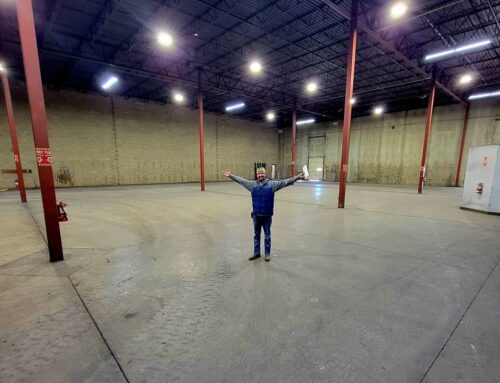Despite Headwinds, One Climate Group Sees Opportunity Ahead for Clean Power
November 8, 2025
Given the recent plight of America’s renewable energy industry, one could be forgiven for viewing its near future with pessimism.
Since returning to office, President Donald Trump has launched an all-out assault against two of the most prominent sources of clean energy—wind and solar.
Trump has lambasted the technologies as the “scam of the century” while providing what critics describe as giveaways to the fossil fuel industry, increasing lease sales for drilling and mandating that millions of acres of federal lands be made available for mining.
His signature One Big Beautiful Bill Act significantly accelerated the phaseout of tax credits for wind and solar projects, pulling back on commitments made under the Inflation Reduction Act several years prior.
Get Inside Clean Energy
Today’s Climate
Tuesdays
A once-a-week digest of the most pressing climate-related news, written by Kiley Price and released every Tuesday.
Get Today’s Climate
Breaking News
Don’t miss a beat. Get a daily email of our original, groundbreaking stories written by our national network of award-winning reporters.
Get Breaking News
ICN Sunday Morning
Go behind the scenes with executive editor Vernon Loeb and ICN reporters as they discuss one of the week’s top stories.
Get ICN Sunday Morning
Justice & Health
A digest of stories on the inequalities that worsen the impacts of climate change on vulnerable communities.
Get Justice & Health
Even renewable projects already in progress have suffered. Empire Wind 1 and Revolution Wind, two offshore wind projects in the Northeast that were under construction, received stop work orders from the Trump administration before ultimately being allowed to proceed.
Despite those headwinds, one pro-renewable group is offering something that’s been hard to come by lately: optimism.
“I really don’t think that this is a time for despair and withdrawal,” said Dan Stein, founder and executive director of the nonprofit Giving Green.
In a new report released on Wednesday, the research and grant-making organization highlighted what it sees as two opportunities to advance clean energy in a bipartisan fashion, even in an intensely polarized environment: commercializing what it describes as “clean firm power” technologies such as nuclear and geothermal, and addressing barriers to clean energy deployment such as federal permitting delays.
The report challenges concerns that clean energy is a lost cause under the Trump administration. Instead, the group’s strategy sees room to work directly with the administration on clean energy policy—rejecting the idea that advocates should shift their focus away from federal action in favor of an exclusive focus on state and local policies.
According to Giving Green, clean firm power refers to technologies that can produce emissions-free electricity on demand and over long periods of time. This differs from technologies like wind and solar, which don’t provide consistent energy throughout the day or across seasons.
Stein acknowledges that wind and solar play an important role in decarbonizing the energy grid since they are the cheapest and most technologically ready clean energy sources. However, he argues that the limitations of those technologies’ ability to provide consistent energy mean that they likely aren’t suitable to provide 100 percent of future electricity needs.
“You need to kind of bend over backwards the more and more you put solar and wind on the grid,” Stein said. “You need to make sure that you have big transmission lines to move energy around from the places where the wind is blowing, you need some batteries that will move power from day to night and even maybe from summer to winter.”
According to Armond Cohen, executive director and founder of Clean Air Task Force—which was awarded a two-year, $4 million grant by Giving Green on Wednesday—that means clean energy advocates need to start pressing for additional energy solutions.
“We can quibble over whether 80 percent of the problem can be solved with wind and solar or 50 percent, but I think there’s pretty much an emerging consensus that that is not 100 percent,” Cohen said.
To fill those gaps, Giving Green’s strategy aims to boost alternative technologies it believes could most benefit from philanthropic intervention.
The report highlights two technologies in particular—“next-gen” geothermal and nuclear fission—as top priorities due to their feasibility, scale and funding needs.
Those two technologies have been left largely unscathed by the Trump administration’s attacks on renewable energy—and in some cases have even received its explicit support.
Energy Secretary Chris Wright included advanced nuclear and geothermal power in his first secretarial order as part of the department’s vision to “unleash American energy innovation.” And in the One Big Beautiful Bill Act, tax credits for nuclear and commercial-scale geothermal projects were largely preserved even as those for wind and solar were drawn back.
For years, geothermal energy has largely been restricted to areas with significant volcanic or tectonic activity, with easily accessible heat, steam or hot water close to the Earth’s surface. Because of those limitations, large-scale geothermal projects have been geographically limited—found mainly in regions such as Iceland, New Zealand and the western United States.
However, technological advances in the oil and gas industry have opened up new opportunities for geothermal exploration.
According to Jamie Beard, founder and executive director of the geothermal nonprofit Project InnerSpace, hydraulic fracturing—which helped touch off the boom in U.S. natural gas along with horizontal drilling—can now be used to tap into the energy source in locations and at a scale that wasn’t previously possible.
Project InnerSpace, which has previously received funding from Giving Green and was just announced as a recipient of its next round of grants, is developing additional tools and technologies to tap into that new potential.
According to Beard, one of the largest barriers to geothermal development she heard from the private sector, governments and funders was an inability to know where they should drill. In response, Project InnerSpace developed GeoMap—which Beard describes as “Google Earth for geothermal.”
Unlike similar paid services that Beard says can sometimes cost millions of dollars, GeoMap is free. It allows stakeholders to utilize hundreds of layers of subsurface and surface data to analyze the expected cost of geothermal projects anywhere in the world.
“Funding entities are using it for diligence. Governments are using it to build policy. Every geothermal startup in the world uses it,” Beard says.
She thinks those advances—along with model projects the group has helped develop through its “GeoFund”—will help make geothermal energy an attractive investment even for companies that traditionally rely on fossil fuel extraction.
“How do you build a business model for geothermal that will actually attract the oil and gas industry? A business model where they will want to drill for geothermal, because it makes business sense for them to drill for geothermal?” Beard said.
“If we crack that code, you crack geothermal at scale globally.”
Some oil and gas companies have shown interest in the technology in recent years. Devon Energy invested $100 million into a Houston geothermal startup in early 2024, while BP and Chevron took part in a $40 million investment round for startup Eavor Technologies in 2021.
Still, there is likely some way to go before Beard’s vision comes to fruition. According to a 2024 report from the International Energy Agency, only about 15 percent of geothermal capacity is currently operated by oil and gas companies. And the industry has been slower to embrace geothermal compared to other clean energy investments, says the Journal of Petroleum Technology.
Next-generation nuclear fission, too, was highlighted by Green Giving’s report as a key opportunity to promote clean firm power.
Nuclear accounts for roughly 20 percent of the U.S. power supply, but building out additional capacity has been constrained by cost, Stein said.

Safety regulations put in place after the partial meltdown at Three Mile Island in 1979 have led to a much more complex and lengthy approval process for new nuclear projects, according to Stein. In addition, because these projects are significant undertakings, they face the same considerable regulatory hurdles that any major infrastructure project is required to undergo.
“The same reason it takes billions of dollars to build a subway in Manhattan is like the same reason it takes billions of dollars for [nuclear development],” Stein said.
But similar to geothermal energy, Giving Green sees recent technological advances in nuclear power as an opportunity to build new projects at greater speed and reduced costs than previously possible.
“The promise of these next-generation nuclear designs is that they can be more modular,” Stein said. “Learn how to build it, get it permitted, get it approved, learn how to build it really well, and then build it over and over and over.”
This story is funded by readers like you.
Our nonprofit newsroom provides award-winning climate coverage free of charge and advertising. We rely on donations from readers like you to keep going. Please donate now to support our work.
Giving Green’s report acknowledges the hurdles that will have to be cleared to achieve those goals. Advanced nuclear—like next-gen geothermal—is not yet a mature technology and will require sustained research, development and demonstration before it can move toward widespread and competitive deployment, the report says.
It also highlights risks about the viability of advanced nuclear, saying that the technological progress and political conditions that its future depends on are uncertain.
Beyond highlighting philanthropic opportunities to advance clean firm power, the report also says clean energy deployment of all forms, including wind and solar, need better regulatory processes—from accelerating federal permitting to modernizing the interconnection process.
Federal permitting reform, in particular, has received significant bipartisan attention in recent months—and support from industries across the energy sector.
One such legislative attempt, the SPEED Act, was introduced by Republican Rep. Bruce Westerman (R-Ark.), chairman of the House Natural Resources Committee, and committee member Rep. Jared Golden (D-Maine).
The bill would make significant changes to how the federal government conducts environmental reviews under the National Environmental Policy Act (NEPA), considered the bedrock of environmental law.
Those changes would include limits on what projects would be subject to NEPA review and the scope of those reviews; raise the bar for courts to overturn the decisions of federal agencies overseeing those reviews; and establish a 150-day deadline to sue federal agencies over their permitting decisions—a drastic reduction from the current six-year statute of limitations for energy projects.
However, some Democrats and environmental groups have cast doubt on whether the benefits of any permitting reform bill, even a technology-neutral one, would be felt equally across the energy sector.
“I am personally deeply skeptical that we can negotiate in good faith right now to try to accelerate permitting of any kind, while there is an ongoing bad faith attack against solar and wind,” Rep. Mike Levin (D-Calif.) said during a September hearing for the bill.
That sentiment was echoed by critics such as Marlyn Twitchell, senior attorney at the Western Environmental Law Center.
“Given the administration’s war on renewable energy projects, this bill would do little but SPEED the climate crisis and the fires, floods, droughts, hurricanes, and oppressive heat that have already killed so many Americans and so severely damaged our homes, public lands, and economy,” Twitchell said in a September press release.
Stein acknowledged those fears but sees a way forward.
“I do share those concerns that the devil is really going to be in the details,” Stein said. “I think I’ve seen some senators say, ‘If there’s going to be permitting reform, we need some legal guarantee that the administration will not just cancel renewables projects.’ And I do think that that’s something that could be built into any legislation.”
To Stein, the promise of technological advances and bipartisan support for clean firm power, plus the potential to find compromise on deploying clean power more efficiently, leaves significant room for hope despite the political climate.
“I think that despite headwinds, there’s a lot that civil society can do at all levels,” Stein said. “It is a responsibility we have to try to bridge the gap and solve problems, rather than withdrawing to our specific camps or specific places where people agree with us.
“So I kind of want to be the voice for optimism here and say, ‘Look, it’s tough times, but we can still get things done—and this is a long-term fight.’”
Cohen, the head of Clean Air Task Force, agreed.
“Climate is a marathon, not a sprint,” he said. “So this too shall pass.”
About This Story
Perhaps you noticed: This story, like all the news we publish, is free to read. That’s because Inside Climate News is a 501c3 nonprofit organization. We do not charge a subscription fee, lock our news behind a paywall, or clutter our website with ads. We make our news on climate and the environment freely available to you and anyone who wants it.
That’s not all. We also share our news for free with scores of other media organizations around the country. Many of them can’t afford to do environmental journalism of their own. We’ve built bureaus from coast to coast to report local stories, collaborate with local newsrooms and co-publish articles so that this vital work is shared as widely as possible.
Two of us launched ICN in 2007. Six years later we earned a Pulitzer Prize for National Reporting, and now we run the oldest and largest dedicated climate newsroom in the nation. We tell the story in all its complexity. We hold polluters accountable. We expose environmental injustice. We debunk misinformation. We scrutinize solutions and inspire action.
Donations from readers like you fund every aspect of what we do. If you don’t already, will you support our ongoing work, our reporting on the biggest crisis facing our planet, and help us reach even more readers in more places?
Please take a moment to make a tax-deductible donation. Every one of them makes a difference.
Thank you,
Search
RECENT PRESS RELEASES
Related Post





